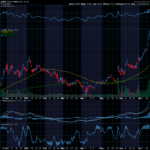by Jon Najarian
The options plays you execute will depend largely upon two things: your risk tolerance and your portfolio goals. Risk and reward are directly proportional – the higher one is, the higher the other is as well. If you have a high risk-tolerance and your aim is to make 200 percent on your money, then you’re probably going to follow an aggressive option strategy. If your risk tolerance and your investment goals are more middle-of-the-road – meaning, you’ll be satisfied with say, a 30 percent return and don’t want to risk more capital than is absolutely necessary – then you’re likely to adhere to a more conservative spreading technique.
Spreading, which involves selling one type of option and buying another, is one of the most common ways to create positions that match your outlook for a given stock or index and limit your risk. Depending on the type of strategy you choose, these spreads can limit your upside potential as well. The trade-off of capping your risk, in return for a limit on the upside, usually is one that many investors are willing to make.
Consider for example, buying an out-of-the-money (OTM) call at the 55 strike with a $5 premium that’s two months out and selling a nearby OTM call at the 65 strike for $2. The worst thing that can happen, no matter how much the market moves, is you might lose $3, the difference between the $5 paid and the $2 you received. And the most you can make, no matter if the stock doubles in price, is $7, which is the difference in price between the strike you purchased and the strike you sold.

We use strategies that involve stock options that, by definition, are American-style options. American-style options may be exercised at the buyer’s discretion at any time, from the moment of purchase until expiration. The buyer of the option, not the seller, may elect to take these actions. Usually, the only time an American-style option – such as a stock option – is exercised at expiration is when the strike price is in-the-money (ITM).
The other type of option contracts are known as European-style options, which are “frozen” and can only be exercised on the day or expiration. These options involve mostly stock indexes in the United States, such as options on the S&P 500 Stock Index, which are traded at the Chicago Board Options Exchange. This type of option is popular with institutions that normally want to stay in their short positions until expiration.
Because American-style options can be exercised at any time, it’s imperative that you are hedged, particularly if you are selling an option. The only time we advocate retail investors selling options is as part of a spread. If you are not adequately hedged, there is a risk that, if you’re a seller of an option, the buyer may “call” the stock from you or “put” the stock to you when that option is in-the-money. If you are un-hedged or “naked” on even one options contract, you could have a very bad day if the stock moves against you.
For that reason, spreading is a very appealing way of controlling risks, hedging positions, and ultimately, preserving capital. I just believe it is a less risky way to speculate in a stock, rather than just buying the shares outright. For example, let’s say IBM is trading at $100 a share. Do you want to hold the stock and commit that much of your capital? Or do you want to buy a call to be long IBM for a $5 premium (each option is 100 shares, so such a position would cost 100 x 5 or $500 per contract), which you hope will increase in value as the stock price rises and the option moves further into the money. Or, do you want to take the next step, and not only buy the $100 call for a $5 premium, but sell a $110 call and collect a $2 premium.
Again, I do not advocate retail investors selling options naked, but using conservative strategies, the investor owns one option for each he or she has sold, so they are not naked any contracts. Collecting the premium when you sell an option may look as easy as picking up dimes on the pavement. But if you’re not careful, a bulldozer rumbling down the street could knock you down. The only time a retail investor should sell options is when it’s part of a carefully constructed spreading strategy.










Recent Comments